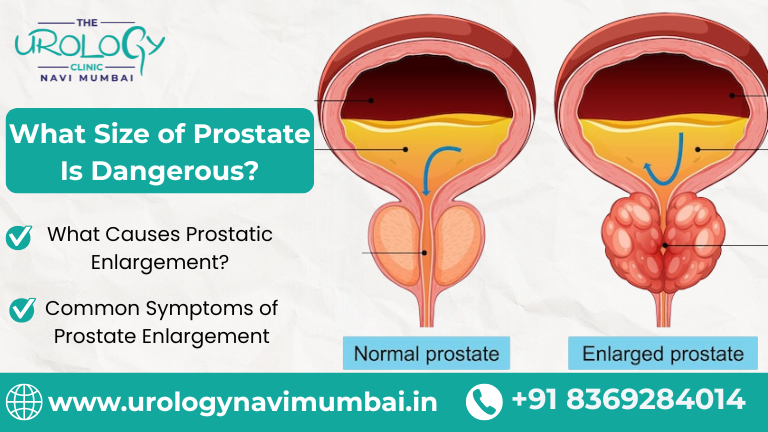What Size of Prostate Is Dangerous? Book An Apppointment The prostate is a small gland in men, usually the size of a walnut, but it plays a very big role in health. It helps make the fluid that mixes with sperm to form semen, which is important for fertility. But sometimes, this gland grows larger than normal. A small increase in size is natural with age, but too much growth can cause serious problems. So, the big question is: what size of prostate is dangerous? Doctors often measure the prostate in cc (cubic centimeters). The normal size of prostate in cc for younger men is about 20–30 cc. If the prostate grows beyond 40–50 cc, it is considered enlarged. Once it crosses 80–100 cc, it may cause dangerous symptoms, like trouble passing urine, infections, or kidney problems. Understanding prostate size, normal limits, and when to seek help can protect men’s health. The Prostate Gland and Its Role in Men’s Health The prostate sits just below the bladder and surrounds the urethra, the tube that carries urine and semen out of the body. Its main function is to produce fluid that keeps sperm healthy. A healthy prostate is important not just for fertility but also for comfortable urination. That’s why knowing what size of prostate is dangerous helps men act early if problems start. Normal Prostate Size Doctors measure prostate size using tests like ultrasound or MRI. Normally, the prostate weighs about 20–30 grams and has a volume of 20–30 cc. Normal Prostate Measurements Length: 3–4 cm Width: 4–5 cm Thickness: 2–3 cm Volume: 20–30 cc (normal size of prostate in cc) As men age, the prostate grows slowly. By the age of 60, a volume of around 30–40 cc may still be normal. Prostate Size Chart by Age A prostate size chart by age helps doctors and patients understand what is normal at different stages of life. Age Group Normal Size (cc) What Doctors Consider Enlarged 20–30 yrs 20–30 cc Above 35 cc 40–50 yrs 25–35 cc Above 40 cc 60–70 yrs 30–40 cc Above 50 cc 70+ yrs 35–45 cc Above 60 cc This chart shows that some growth is natural with age. But when it goes too far, it raises the question: what size of prostate is dangerous? What Is Considered an Enlarged Prostate? An enlarged prostate is also called Benign Prostatic Hyperplasia (BPH). It is not cancer, but it can still cause problems. Enlarged Prostate Measurements Normal size of prostate: 20–30 cc Mild enlargement: 30–40 cc Moderate enlargement: 40–80 cc Severe enlargement (dangerous): Above 80–100 cc So, how big is too big? For most men, once the prostate reaches 80–100 cc, it becomes dangerous because it can block urine flow and damage the kidneys. What Causes Prostatic Enlargement? The exact cause of prostate growth is not fully known, but doctors believe these factors play a role: Age: Most common in men over 50. Hormonal changes: Testosterone and other hormones affect growth. Lifestyle: Poor diet, obesity, and lack of exercise can worsen enlargement. Genetics: Family history increases the risk. Common Symptoms of Prostate Enlargement When the prostate grows too large, it squeezes the urethra, causing: Weak urine flow Difficulty starting urination Frequent urination, especially at night Feeling bladder is not empty Dribbling after urination In severe cases, inability to pass urine These symptoms often make men ask their doctor, what size of prostate is dangerous for me? What Happens if an Enlarged Prostate Is Left Untreated? Ignoring prostate enlargement can lead to: Bladder damage Urinary infections Kidney damage Bladder stones Complete urinary blockage (medical emergency) That is why understanding normal size of prostate and when it becomes dangerous is very important. Treatment Options for Enlarged Prostate Treatment depends on how large the prostate is and the symptoms. Medicines Doctors may give medicines to relax muscles or shrink the prostate. Minimally Invasive Treatments PAE (Prostate Artery Embolization): Blocks blood flow to shrink the prostate. Laser surgery: Removes extra tissue. Surgery For very large prostates (above 100 cc), surgery may be the best choice. Why More Men Are Choosing PAE Treatment for BPH PAE is becoming popular because: No large cuts are needed. Shorter hospital stay. Faster recovery. Safe for men who cannot undergo big surgery. This option is helping many men with enlarged prostates live better lives. Recommendations for Enlarged Prostate Diet Food plays an important role in prostate health. Doctors often warn men about the ten worst foods for prostate health, such as: Red meat Processed foods Fried foods Too much dairy Spicy food Sugary drinks Excess alcohol Caffeine High-salt snacks Fast food Instead, eat: Tomatoes (rich in lycopene) Green vegetables Fish with omega-3 Nuts and seeds Whole grains A good diet helps control prostate growth and keeps symptoms under check. What Is the Recovery Time After Enlarged Prostate Surgery? Recovery depends on the type of treatment: PAE or laser surgery: 1–2 weeks Traditional surgery: 4–6 weeks During recovery, doctors advise drinking more water, avoiding heavy lifting, and following a healthy diet. FAQs What size of prostate is dangerous for urination? Anything above 80–100 cc is considered dangerous because it blocks urine flow. Can prostate enlargement turn into cancer? BPH is not cancer, but symptoms can be similar. Regular check-ups are important. What is the normal size of prostate in cc? The normal prostate size is around 20–30 cc in young men. Can food affect prostate size? Yes. Eating the ten worst foods for prostate health can make symptoms worse, while healthy foods can improve recovery. Anything above 80–100 cc is considered dangerous because it blocks urine flow. BPH is not cancer, but symptoms can be similar. Regular check-ups are important. The normal prostate size is around 20–30 cc in young men. Yes. Eating the ten worst foods for prostate health can make symptoms worse, while healthy foods can improve recovery. Why Choose The Urology Clinic Navi Mumbai? When it comes to prostate health, you need a trusted doctor who listens and cares. At The Urology Clinic



